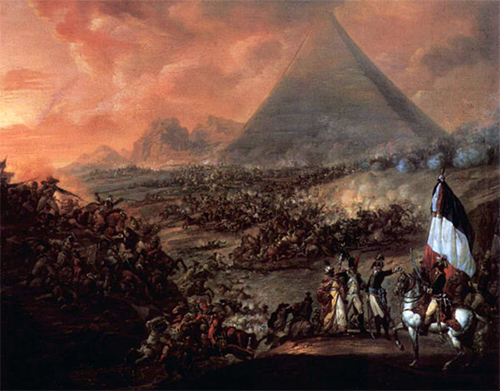The Battle of the Pyramids
The Battle of the Pyramids was a victory for France over combined forces of the Ottoman Empire and the Egyptian Mameluks during the War of the First Coalition. The battle took place on July 21, 1798. 
The French government earlier that year had tasked Napoleon Bonaparte (left) with planning an invasion of Great Britain, which was part of the First Coalition. Bonaparte concluded that the French navy didn't have the firepower to compete with the British Royal Navy and that it would better to strike a blow against British interests in the Middle East, specifically by invading Egypt and Syria, in an attempt to interfere with Britain's trade routes to India. This was more practical than it had been because Britain and Spain had gone to war in 1796 and the British naval force in the Mediterranean was little more than the outpost at Gibraltar. The Directory, the ruling executive at that time, agreed, and Bonaparte began planning his expedition. Bonaparte and 35,000 soldiers, aboard 200 ships, sailed for Egypt in May. They captured Malta (home to the remnants of the Knights Hospitaller), on June 9 and then overran Alexandria in early July. 
French troops marching from Alexandria to Cairo encountered a large force of Mameluks and the army of the Ottoman Empire, about four miles from the capital and nine miles from the Pyramids. The forces were evenly matched in terms of overall strength, with France having 20,000 men in total and the Mameluks having a total of 21,000 soldiers; however, the Mameluks had twice as many cavalry, numbering 6,000, and their cavalry was known for their overwhelming success. Bonaparte deployed much his infantry in a formation known as the Infantry Square, a tactic dating to Roman times that involved infantry forming in a square in order to counter the effects of a cavalry charge. In this case, the French deployed cannons at the corners of the squares. The idea was to wait until the horses were close enough and then fire. The French squares executed the strategy well enough to prevent more than one cavalry charge. The rest of the French force attacked the enemy in the nearby village of Embabeh. Trapped between French attackers and the Nile, a number of Mameluks and Ottomans tried to swim across the river; hundreds of them drowned. The defeat inflicted on the losing force was nearly complete demolition, in combined deaths and injuries. French troops, meanwhile, suffered 29 deaths and more than 250 wounded.
|
|
Social Studies for Kids
copyright 2002–2026
David White




